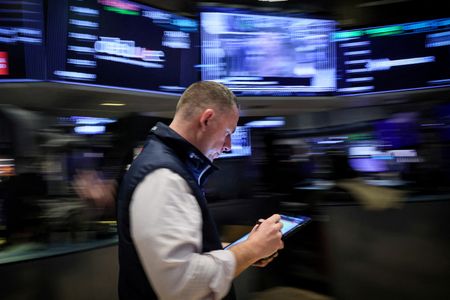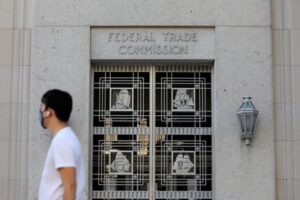By Stephen Culp
NEW YORK (Reuters) -U.S. stocks closed slightly lower on Tuesday, breaking their recent winning streak amid few market-moving catalysts ahead of the Jackson Hole Economic Symposium, set to get under way on Thursday.
All three major U.S. stock indexes edged down, ending a multi-session rally in which the equities market bounced back from a steep sell-off driven by recession fears.
“Last week was the best week of the year for stocks, which begs the question whether the rally will continue,” said Chuck Carlson, chief executive officer at Horizon Investment Services in Hammond, Indiana.
“But I don’t think today is indicative of a trend change,” he added. “Investors are taking a pause and they’re sleepy now after feasting for the last couple weeks.”
The eight days of consecutive daily gains were the longest winning streaks for the S&P 500 and the Nasdaq since November and December, respectively.
On Thursday, representatives from central banks around the globe are expected to converge in Jackson Hole, Wyoming, for their annual Economic Symposium, at which U.S. Federal Reserve Chair Jerome Powell is expected to deliver remarks on Friday.
Powell’s speech will be parsed by market participants for hints regarding the number and timing of expected policy rate cuts this year and next.
“The question is, is the rate cut going to be 25 or 50 basis points, and I think that’s where a lot of the reading between the lines is going to happen, trying to see how aggressive that first cut is going to be,” Carlson said.
Financial markets are currently pricing in a 69.5% likelihood of a 25 basis-point reduction of the Fed funds target rate at the conclusion of the Federal Open Market Committee meeting in September, with a 30.5% chance of a super-sized cut of 50 basis points, according to CME’s FedWatch tool.
On Wednesday, the Labor Department is expected to release preliminary benchmark revisions to its employment data for the 12 months through March. A significant downward revision to the data could potentially affect the data-dependent Fed’s policy path.
The Democratic National Convention in Chicago entered its second day on Tuesday as election-year tensions potentially exacerbate market swings at a time when the light volume typical of late summer trading can trigger market volatility.
The Dow Jones Industrial Average fell 61.56 points, or 0.15%, to 40,834.97, the S&P 500 lost 11.13 points, or 0.20%, to 5,597.12 and the Nasdaq Composite dropped 59.83 points, or 0.33%, to 17,816.94.
Among the 11 major sectors of the S&P 500, energy stocks suffered the largest percentage drop, sliding 2.7%. Consumer staples led the gainers, rising 0.5%.
Eli Lilly’s weight-loss drug Zepbound was shown to drastically cut the risk of developing Type 2 diabetes in pre-diabetic adults, sending the drugmaker’s shares up 3.1%.
Cybersecurity firm Palo Alto Networks jumped 7.2% after its fiscal 2025 revenue and profit forecasts beat analyst estimates.
Boeing’s shares slid 4.2% in the wake of the U.S. Federal Aviation Administration’s announcement that it was adopting an airworthiness directive for the planemaker’s 787 Dreamliner.
Declining issues outnumbered advancing ones on the NYSE by a 1.55-to-1 ratio; on Nasdaq, a 1.84-to-1 ratio favored decliners.
The S&P 500 posted 38 new 52-week highs and no new lows; the Nasdaq Composite recorded 75 new highs and 72 new lows.
Volume on U.S. exchanges was 9.93 billion shares, compared with the 12.22 billion average for the full session over the last 20 trading days.
(Reporting by Stephen Culp in New YorkAdditional reporting by Shashwat Chauhan and Johann M Cherian in BengaluruEditing by Matthew Lewis)





